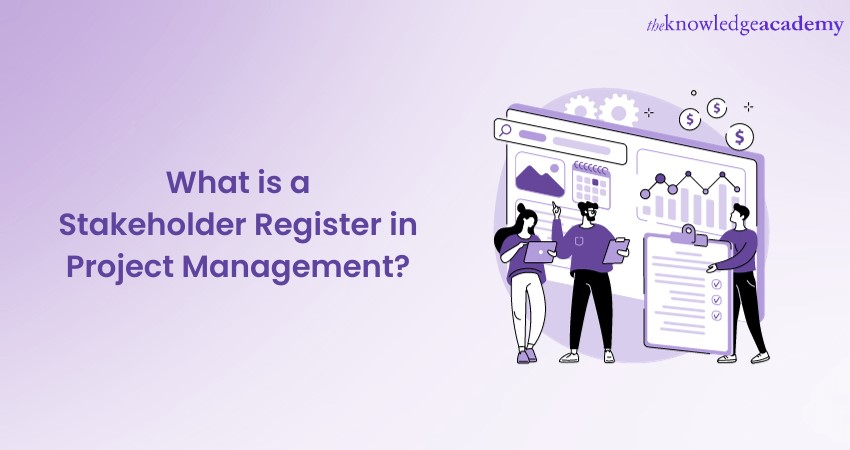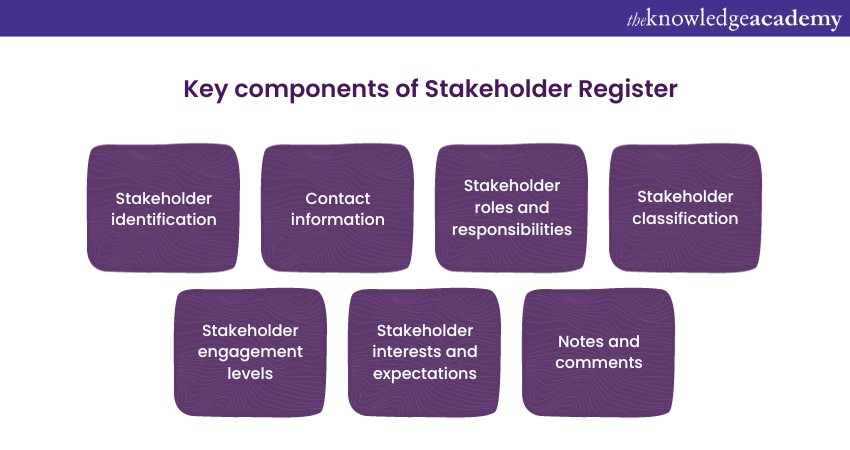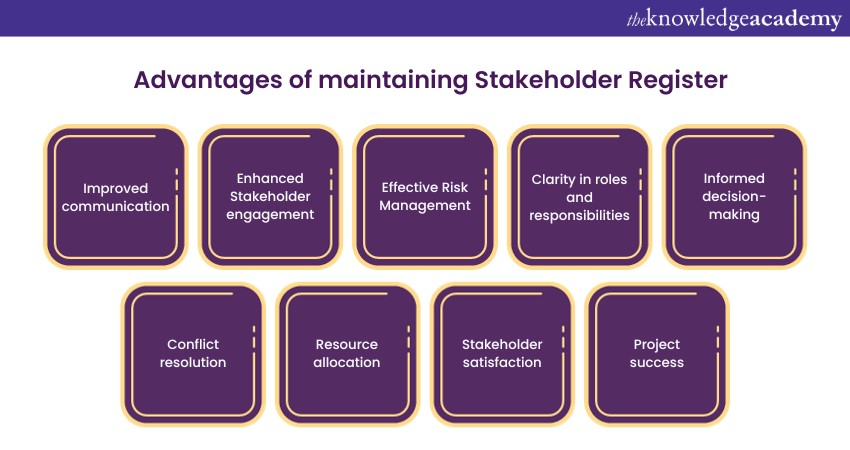We may not have the course you’re looking for. If you enquire or give us a call on + 1-866 272 8822 and speak to our training experts, we may still be able to help with your training requirements.
Training Outcomes Within Your Budget!
We ensure quality, budget-alignment, and timely delivery by our expert instructors.

Project Management is a complex and challenging endeavour that requires careful planning, Project Execution, monitoring, and control of various aspects of a project. One of the most critical aspects is Stakeholder Management, which is the process of identifying, engaging, and communicating with the people who have an interest or influence on the project's outcome. To do this effectively, you need a Stakeholder Register.
A Stakeholder Register is a key concept in Project Management and a vital tool for successful Stakeholder Management. But what makes it a vital tool, and how is it crucial in managing projects? Let's find out. Read this blog to learn What is a Stakeholder Register, what it contains, how to create one, and how to use it throughout the project lifecycle.
Table of Contents
1) Defining Stakeholder Register
2) How to create a Stakeholder Register?
3) How to use a Stakeholder Register effectively?
4) Advantages of using a Stakeholder Register
5) Conclusion
Defining Stakeholder Register
A Stakeholder Register is a vital document or database for Project Management, as it contains essential information about the people, groups, or entities who have a stake in a specific project. It acts as a central source of information for managing Stakeholder relationships and ensuring project success. Here are the key components and information typically included in a Stakeholder Register:

a) Stakeholder identification: It means the names and titles of all identified Stakeholders and the organisations or groups to which they belong.
b) Contact information: Contact details such as phone numbers, email addresses, and mailing addresses for each Stakeholder.
c) Stakeholder roles and responsibilities: The roles and responsibilities of every Stakeholder in relation to the project. It involves their specific functions, duties, and contributions to the project.
d) Stakeholder classification: Stakeholders are often classified based on criteria such as their level of influence over the project and their level of interest or impact on project outcomes. Common classifications include "High Influence, High Interest," "High Influence, Low Interest," "Low Influence, High Interest," and "Low Influence, Low Interest."
e) Stakeholder engagement levels: The level of engagement or interaction required for each Stakeholder. This can range from "unaware" (no need for regular communication) to "active" (frequent and detailed communication).
f) Stakeholder interests and expectations: It describes each Stakeholder's specific interests, expectations, concerns, and objectives related to the project. This information helps Project Managers tailor communication and engagement strategies.
g) Historical information: It is the relevant historical data or previous interactions with Stakeholders. This can include feedback, issues, or disputes from past projects that may impact the current project.
h) Notes and comments: These are additional notes or comments about specific Stakeholders or any other pertinent information.
How to create a Stakeholder Register?
Creating an effective Stakeholder Register is a crucial step in Project Management to ensure that Stakeholders' interests, expectations, and concerns are adequately managed throughout the Project Lifecycle. Here are the key steps and considerations for creating an effective Stakeholder Register:
1) Identify Stakeholders: The first step in creating a Stakeholder Register is to identify all potential Stakeholders who may be interested in the project. This includes both internal and external Stakeholders. Stakeholders can include team members, Project Sponsors, customers, regulatory authorities, suppliers, and more.
2) Gather Stakeholder information: This step includes the following:
a) Collecting relevant information about each Stakeholder, such as their name, role, contact details, organisation, and position.
b) Determining their level of influence over the project and their level of interest or impact on project outcomes.
c) Identifying any specific needs, expectations, concerns, or requirements they may have related to the project.
3) Classify Stakeholders: Categorise Stakeholders based on their level of influence and interest. This classification helps in determining the appropriate level of engagement and communication for each group. Common categories include the following:
a) High Influence, High Interest
b) High Influence, Low Interest
c) Low Influence, High Interest
d) Low Influence, Low Interest
4) Define engagement levels: For each Stakeholder group, specify how you plan to engage with them throughout the project. Engagement levels can vary from unaware (no need for communication) to active (frequent and detailed communication). Tailor your engagement strategy to meet the specific needs of each group.
5) Prioritise Stakeholders: Prioritising Stakeholders is essential, as it helps you allocate resources and attention effectively. Focus more on Stakeholders with high influence and high interest, as they have the potential to significantly impact the project's success.
6) Document the Register: Create a formal document or digital database to house all the gathered Stakeholder information. The Stakeholder Register typically includes the following:
a) Stakeholder names and contact details
b) Stakeholder Roles and Responsibilities
c) Classification of Stakeholders (e.g., based on influence and interest)
d) Stakeholder engagement levels
e) Specific needs, expectations, and concerns
f) Any relevant historical information or past interactions
7) Regularly update the Register: The Stakeholder Register is not a one-time activity. It needs to be dynamic and kept up to date throughout the project. As Stakeholder dynamics change or new Stakeholders emerge, make the necessary updates to ensure that the information remains accurate and relevant.
8) Utilise the Register to its optimum: The Stakeholder Register should serve as a foundational reference document for Project Managers and team members. It must guide communication plans, involve risk mitigation strategies, and decision-making processes. Regularly refer to the Register when planning project activities and Stakeholder engagements.
9) Engage Stakeholders actively: Use the information in the Stakeholder Register to engage them effectively. Develop communication plans and strategies tailored to each Stakeholder group's needs and preferences. Ensure that each one of them is kept informed and their concerns are addressed promptly.
10) Feedback and evaluation: Encourage feedback from Stakeholders and use their input to refine project strategies. Regularly evaluate the effectiveness of your Stakeholder engagement efforts and adjust them as needed.
Master the art of Project Management with our Project Management Office Fundamentals Certification Course and take your career to new heights!
How to use a Stakeholder Register effectively?
Now that you have created a Stakeholder Register, here's how to effectively use it throughout the project's lifecycle:
a) Communication and engagement planning: Refer to the Stakeholder Register to plan your communication and engagement strategies. Tailor your messages and interactions to align with each Stakeholder's interests, expectations, and level of influence.
b) Risk management: The Stakeholder Register aids in risk assessment and management. By understanding their interests and concerns, you can identify risks and develop strategies to solve them. This proactive approach h within the Risk Management Process minimises the likelihood of project disruptions.
c) Decision-making: During the discussion with Stakeholders at any stage of the project, consult the Stakeholder Register. It provides insights into how different Stakeholders may be affected by various choices. Informed decision-making helps maintain Stakeholder satisfaction and project alignment.
d) Conflict resolution: In the event of conflicts among Stakeholders, the Register serves as a reference point. It helps Project Managers understand the underlying issues and devise solutions that address the concerns of all parties involved.
e) Feedback and monitoring: Use the Stakeholder Register to track Stakeholder feedback and monitor their evolving interests and expectations. Regularly update the Register to reflect changes in Stakeholder dynamics.
f) Resource allocation: Allocate project resources, such as time and budget, based on the priorities and needs of Stakeholders. The Stakeholder Register guides resource allocation decisions, ensuring that resources are used effectively to meet Stakeholder requirements.
g) Project success evaluation: After project completion, assess the overall success and Stakeholder satisfaction. The Stakeholder Register serves as a valuable reference to measure whether Stakeholder expectations were met and whether the project achieved its objectives.
Advantages of using a Stakeholder Register
Stakeholder Register is a fundamental tool in Project Management, and its benefits are significant in ensuring project success. Here are the key advantages of maintaining this Register:

1) Improved communication: A Stakeholder Register provides a centralised database of contact information for all Stakeholders involved in a project. This streamlines the Project Communication Plan by making it easy to reach out to the right people with relevant information. Improved communication reduces misunderstandings, enhances collaboration, and fosters a sense of transparency.
2) Enhanced Stakeholder engagement: By documenting Stakeholders' interests, expectations, concerns, and objectives, the Register allows Project Managers to tailor their engagement strategies. Understanding and addressing the needs of each Stakeholder group enhances their engagement and commitment to the project.
3) Effective risk management: Identifying and categorising Stakeholders in the Register enables Project Managers to assess potential risks associated with each group. This proactive approach allows for the development of risk mitigation strategies that can prevent project delays, cost overruns, or conflicts related to Stakeholder issues.
4) Clarity in roles and responsibilities: The Stakeholder Register refines the roles and responsibilities of each Stakeholder. It helps in ensuring that everyone involved in the project understands their specific contributions. This, in turn, helps reduce confusion and the risk of tasks falling through the cracks.
5) Informed decision-making: When making project-related decisions, Project Managers can consult the Stakeholder Register to understand how different Stakeholders may be affected. Informed decision-making helps ensure that project choices align with Stakeholder interests and expectations.
6) Conflict resolution: In the event of conflicts among Stakeholders, the Stakeholder Register serves as a valuable reference. It provides insights into the underlying issues and helps Project Managers devise solutions that address Stakeholders' concerns, ultimately fostering a more harmonious project environment.
7) Resource allocation: The Register aids in resource allocation decisions, ensuring that project resources, such as time and budget, are allocated based on Stakeholder priorities. This prevents resource wastage and helps meet Stakeholder requirements efficiently.
8) Stakeholder satisfaction: Ultimately, the Stakeholder Register plays a critical role in ensuring Stakeholder satisfaction. When they feel heard, engaged, and informed throughout the project, their satisfaction levels increase. Satisfied Stakeholders are more likely to support the project's objectives and outcomes.
9) Project success: The cumulative effect of these benefits is increased project success rates. When communication is efficient, Stakeholders are engaged, risks are managed, and decisions align with Stakeholder interests, projects are likely to meet their objectives, stay on schedule, and remain within budget.
Unlock your potential as a Project Leader with our comprehensive Project Management Courses – start today and steer your career towards success!
Conclusion
Stakeholder Register is not just a document; it's a dynamic tool that empowers Project Managers to navigate the intricate web of Stakeholder relationships with precision. By fostering transparency, facilitating effective communication, and enabling tailored engagement, this Register becomes an indispensable instrument for project success. It ensures that projects align with the diverse interests and expectations of their Stakeholders, ultimately leading to better outcomes and Stakeholder satisfaction.
Take the first step towards Project Management excellence with our Project Management Certification Course and turn your career ambitions into successful projects!
Frequently Asked Questions
Upcoming Business Skills Resources Batches & Dates
Date
 Introduction to Project Management Course
Introduction to Project Management Course
Fri 17th Jan 2025
Fri 21st Feb 2025
Fri 4th Apr 2025
Fri 6th Jun 2025
Fri 25th Jul 2025
Fri 7th Nov 2025
Fri 26th Dec 2025







 Top Rated Course
Top Rated Course



 If you wish to make any changes to your course, please
If you wish to make any changes to your course, please


